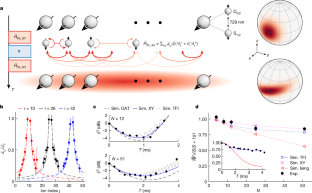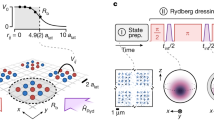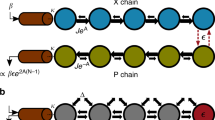Abstract
The control over quantum states in atomic systems has led to the most precise optical atomic clocks so far1,2,3. Their sensitivity is bounded at present by the standard quantum limit, a fundamental floor set by quantum mechanics for uncorrelated particles, which can—nevertheless—be overcome when operated with entangled particles. Yet demonstrating a quantum advantage in real-world sensors is extremely challenging. Here we illustrate a pathway for harnessing large-scale entanglement in an optical transition using 1D chains of up to 51 ions with interactions that decay as a power-law function of the ion separation. We show that our sensor can emulate many features of the one-axis-twisting (OAT) model, an iconic, fully connected model known to generate scalable squeezing4 and Greenberger–Horne–Zeilinger-like states5,6,7,8. The collective nature of the state manifests itself in the preservation of the total transverse magnetization, the reduced growth of the structure factor, that is, spin-wave excitations (SWE), at finite momenta, the generation of spin squeezing comparable with OAT (a Wineland parameter9,10 of −3.9 ± 0.3 dB for only N = 12 ions) and the development of non-Gaussian states in the form of multi-headed cat states in the Q-distribution. We demonstrate the metrological utility of the states in a Ramsey-type interferometer, in which we reduce the measurement uncertainty by −3.2 ± 0.5 dB below the standard quantum limit for N = 51 ions.
This is a preview of subscription content, access via your institution
Access options
Access Nature and 54 other Nature Portfolio journals
Get Nature+, our best-value online-access subscription
$29.99 / 30 days
cancel any time
Subscribe to this journal
Receive 51 print issues and online access
$199.00 per year
only $3.90 per issue
Buy this article
- Purchase on Springer Link
- Instant access to full article PDF
Prices may be subject to local taxes which are calculated during checkout




Similar content being viewed by others
Data availability
The experimental data generated and analysed during this study are available in the Zenodo repository, https://doi.org/10.5281/zenodo.8124375.
Code availability
The code used for simulations in this study is available from the corresponding author on reasonable request.
References
Bothwell, T. et al. Resolving the gravitational redshift across a millimetre-scale atomic sample. Nature 602, 420–424 (2022).
Oelker, E. et al. Demonstration of 4.8 × 10−17 stability at 1 s for two independent optical clocks. Nat. Photon. 13, 714–719 (2019).
McGrew, W. F. et al. Atomic clock performance enabling geodesy below the centimetre level. Nature 564, 87–90 (2018).
Kitagawa, M. & Ueda, M. Squeezed spin states. Phys. Rev. A 47, 5138 (1993).
Agarwal, G., Puri, R. & Singh, R. Atomic Schrödinger cat states. Phys. Rev. A 56, 2249 (1997).
Mølmer, K. & Sørensen, A. Multiparticle entanglement of hot trapped ions. Phys. Rev. Lett. 82, 1835 (1999).
Song, C. et al. Generation of multicomponent atomic Schrödinger cat states of up to 20 qubits. Science 365, 574–577 (2019).
Comparin, T., Mezzacapo, F. & Roscilde, T. Multipartite entangled states in dipolar quantum simulators. Phys. Rev. Lett. 129, 150503 (2022).
Wineland, D. J., Bollinger, J. J., Itano, W. M., Moore, F. L. & Heinzen, D. J. Spin squeezing and reduced quantum noise in spectroscopy. Phys. Rev, A 46, R6797 (1992).
Wineland, D. J., Bollinger, J. J., Itano, W. M. & Heinzen, D. J. Squeezed atomic states and projection noise in spectroscopy. Phys. Rev. A 50, 67 (1994).
Giovannetti, V., Lloyd, S. & Maccone, L. Advances in quantum metrology. Nat. Photon. 5, 222–229 (2011).
Degen, C. L., Reinhard, F. & Cappellaro, P. Quantum sensing. Rev. Mod. Phys. 89, 035002 (2017).
Pezzè, L., Smerzi, A., Oberthaler, M. K., Schmied, R. & Treutlein, P. Quantum metrology with nonclassical states of atomic ensembles. Rev. Mod. Phys. 90, 035005 (2018).
Ludlow, A. D., Boyd, M. M., Ye, J., Peik, E. & Schmidt, P. O. Optical atomic clocks. Rev. Mod. Phys. 87, 637 (2015).
Norcia, M. A. et al. Cavity-mediated collective spin-exchange interactions in a strontium superradiant laser. Science 361, 259–262 (2018).
Ritsch, H., Domokos, P., Brennecke, F. & Esslinger, T. Cold atoms in cavity-generated dynamical optical potentials. Rev. Mod. Phys. 85, 553 (2013).
Leroux, I. D., Schleier-Smith, M. H. & Vuletić, V. Implementation of cavity squeezing of a collective atomic spin. Phys. Rev. Lett. 104, 073602 (2010).
Hosten, O., Engelsen, N. J., Krishnakumar, R. & Kasevich, M. A. Measurement noise 100 times lower than the quantum-projection limit using entangled atoms. Nature 529, 505–508 (2016).
Cox, K. C., Greve, G. P., Weiner, J. M. & Thompson, J. K. Deterministic squeezed states with collective measurements and feedback. Phys. Rev. Lett. 116, 093602 (2016).
Pedrozo-Peñafiel, E. et al. Entanglement on an optical atomic-clock transition. Nature 588, 414–418 (2020).
Bohn, J. L., Rey, A. M. & Ye, J. Cold molecules: progress in quantum engineering of chemistry and quantum matter. Science 357, 1002–1010 (2017).
Schine, N., Young, A. W., Eckner, W. J., Martin, M. J. & Kaufman, A. M. Long-lived Bell states in an array of optical clock qubits. Nat. Phys. 18, 1067–1073 (2022).
Britton, J. W. et al. Engineered two-dimensional Ising interactions in a trapped-ion quantum simulator with hundreds of spins. Nature 484, 489–492 (2012).
Bohnet, J. G. et al. Quantum spin dynamics and entanglement generation with hundreds of trapped ions. Science 352, 1297–1301 (2016).
Perlin, M. A., Qu, C. & Rey, A. M. Spin squeezing with short-range spin-exchange interactions. Phys. Rev. Lett. 125, 223401 (2020).
Bilitewski, T. et al. Dynamical generation of spin squeezing in ultracold dipolar molecules. Phys. Rev. Lett. 126, 113401 (2021).
Comparin, T., Mezzacapo, F. & Roscilde, T. Robust spin squeezing from the tower of states of U(1)-symmetric spin Hamiltonians. Phys. Rev. A 105, 022625 (2022).
Young, J. T., Muleady, S. R., Perlin, M. A., Kaufman, A. M. & Rey, A. M. Enhancing spin squeezing using soft-core interactions. Phys. Rev. Res. 5, L012033 (2023).
Block, M. et al. A universal theory of spin squeezing. Preprint at https://arxiv.org/abs/2301.09636 (2023).
Pezzé, L. & Smerzi, A. Entanglement, nonlinear dynamics, and the Heisenberg limit. Phys. Rev. Lett. 102, 100401 (2009).
Browaeys, A. & Lahaye, T. Many-body physics with individually controlled Rydberg atoms. Nat. Phys. 16, 132–142 (2020).
Bruzewicz, C. D., Chiaverini, J., McConnell, R. & Sage, J. M. Trapped-ion quantum computing: progress and challenges. Appl. Phys. Rev. 6, 021314 (2019).
Tscherbul, T. V., Ye, J. & Rey, A. M. Robust nuclear spin entanglement via dipolar interactions in polar molecules. Phys. Rev. Lett. 130, 143002 (2023).
Gorshkov, A. V. et al. Tunable superfluidity and quantum magnetism with ultracold polar molecules. Phys. Rev. Lett. 107, 115301 (2011).
Foss-Feig, M., Gong, Z.-X., Gorshkov, A. V., and Clark, C. W. Entanglement and spin-squeezing without infinite-range interactions. Preprint at https://arxiv.org/abs/1612.07805 (2016).
Rey, A. M., Jiang, L., Fleischhauer, M., Demler, E. & Lukin, M. D. Many-body protected entanglement generation in interacting spin systems. Phys. Rev. A 77, 052305 (2008).
Kranzl, F. et al. Controlling long ion strings for quantum simulation and precision measurements. Phys. Rev. A 105, 052426 (2022).
Greenberger, D. M., Horne, M. A. & Zeilinger, A. in Bell’s Theorem, Quantum Theory and Conceptions of the Universe (ed. Kafatos, M.) 69–72 (Springer, 1989).
Qiao, M. et al. Observing frustrated quantum magnetism in two-dimensional ion crystals. Preprint at https://arxiv.org/abs/2204.07283 (2022).
Kiesenhofer, D. et al. Controlling two-dimensional Coulomb crystals of more than 100 ions in a monolithic radio-frequency trap. PRX Quantum 4, 020317 (2023).
Itano, W. M. et al. Bragg diffraction from crystallized ion plasmas. Science 279, 686–689 (1998).
Barredo, D., Lienhard, V., de Léséleuc, S., Lahaye, T. & Browaeys, A. Synthetic three-dimensional atomic structures assembled atom by atom. Nature 561, 79–82 (2018).
Bornet, G. et al. Scalable spin squeezing in a dipolar Rydberg atom array. Preprint at https://arxiv.org/abs/2303.08053 (2023)
Eckner, W. J. et al. Realizing spin squeezing with Rydberg interactions in a programmable optical clock. Preprint at https://arxiv.org/abs/2303.08078 (2023).
Campbell, S. L. et al. A Fermi-degenerate three-dimensional optical lattice clock. Science 358, 90–94 (2017).
Davis, E., Bentsen, G. & Schleier-Smith, M. Approaching the Heisenberg limit without single-particle detection. Phys. Rev. Lett. 116, 053601 (2016).
Liu, Y. C., Xu, Z. F., Jin, G. R. & You, L. Spin squeezing: transforming one-axis twisting into two-axis twisting. Phys. Rev. Lett. 107, 013601 (2011).
Marciniak, C. D. et al. Optimal metrology with programmable quantum sensors. Nature 603, 604–609 (2022).
Kaubruegger, R., Vasilyev, D. V., Schulte, M., Hammerer, K. & Zoller, P. Quantum variational optimization of Ramsey interferometry and atomic clocks. Phys. Rev. X 11, 041045 (2021).
Hines, J. A. et al. Spin squeezing by Rydberg dressing in an array of atomic ensembles. Preprint at https://arxiv.org/abs/2303.08805 (2023).
Joshi, M. K. et al. Observing emergent hydrodynamics in a long-range quantum magnet. Science 376, 720–724 (2022).
Zhu, S.-L., Monroe, C. & Duan, L.-M. Trapped ion quantum computation with transverse phonon modes. Phys. Rev. Lett. 97, 050505 (2006).
Wu, C. F. J. Jackknife, bootstrap and other resampling methods in regression analysis. Ann. Stat. 14, 1261–1295 (1986).
Foss-Feig, M., Hazzard, K. R. A., Bollinger, J. J. & Rey, A. M. Nonequilibrium dynamics of arbitrary-range Ising models with decoherence: an exact analytic solution. Phys. Rev. A 87, 042101 (2013).
Schachenmayer, J., Pikovski, A. & Rey, A. M. Many-body quantum spin dynamics with Monte Carlo trajectories on a discrete phase space. Phys. Rev. X 5, 011022 (2015).
Zhu, B. H., Rey, A. M. & Schachenmayer, J. A generalized phase space approach for solving quantum spin dynamics. New J. Phys. 21, 082001 (2019).
Huber, J., Rey, A. M. & Rabl, P. Realistic simulations of spin squeezing and cooperative coupling effects in large ensembles of interacting two-level systems. Phys. Rev. A 105, 013716 (2022).
Muleady, S. R., Yang, M., White, S. R. & Rey, A. M. Validating phase-space methods with tensor networks in two-dimensional spin models with power-law interactions. Preprint at https://arxiv.org/abs/2305.17242 (2023).
Gardiner, C. W. Stochastic Methods: A Handbook for the Natural and Social Sciences 4th edn (ed. Haken, H.) (Springer, 2009).
Roscilde, T., Comparin, T. & Mezzacapo, F. Entangling dynamics from effective rotor/spin-wave separation in U(1)-symmetric quantum spin models. Preprint at https://arxiv.org/abs/2302.09271 (2023).
Roscilde, T., Comparin, T. & Mezzacapo, F. Rotor/spin-wave theory for quantum spin models with U(1) symmetry. Preprint at https://arxiv.org/abs/2303.00380 (2023).
Acknowledgements
We acknowledge stimulating discussions with members of the LASCEM collaboration about realizing spin squeezing in trapped ions with short-range interactions that initiated the project, as well as valuable feedback on the manuscript by W. Eckner and A. Kaufman. We also acknowledge support by the Austrian Science Fund through the SFB BeyondC (F7110) and funding by the Institut für Quanteninformation GmbH, by the Simons Collaboration on Ultra-Quantum Matter, which is a grant from the Simons Foundation, and by LASCEM through AFOSR no. 64896-PH-QC. Support is also acknowledged from the AFOSR grants FA9550-18-1-0319 and FA9550-19-1-0275, by the NSF JILA-PFC PHY-1734006, QLCI OMA-2016244, NSF grant PHY-1820885, by the U.S. Department of Energy, Office of Science, National Quantum Information Science Research Centers, Quantum Systems Accelerator and by NIST.
Author information
Authors and Affiliations
Contributions
The research was devised by S.R.M., M.K.J., R.K., A.M.R. and C.F.R. S.R.M. and A.M.R. developed the theoretical protocols. J.F., M.K.J., F.K., R.B. and C.F.R. contributed to the experimental setup. J.F., M.K.J. and F.K. performed the experiments. M.K.J., J.F. and R.K. analysed the data and S.R.M. carried out numerical simulations. S.R.M., M.K.J., J.F., R.K., A.M.R. and C.F.R. wrote the manuscript. All authors contributed to the discussion of the results and the manuscript.
Corresponding authors
Ethics declarations
Competing interests
The authors declare no competing interests.
Peer review
Peer review information
Nature thanks Sebastian Carrasco, Luming Duan, Michael Goerz and the other, anonymous, reviewer(s) for their contribution to the peer review of this work. Peer reviewer reports are available.
Additional information
Publisher’s note Springer Nature remains neutral with regard to jurisdictional claims in published maps and institutional affiliations.
Extended data figures and tables
Extended Data Fig. 1 Assessment of the experimentally prepared spin state.
a, The outcome of the entangling interaction on the spins pointing along the x-axis is depicted as a variance ellipse. ξ2 is evaluated from two sets of measurements that are obtained after a rotation \(\widehat{R}(\widetilde{\theta },\widetilde{\phi })\) has been applied to the state. b, Applying \(\widehat{R}(\pi /2,\widetilde{\phi })\) for various values of \(\widetilde{\phi }\) allows us to measure the spin projection ⟨\(\widehat{S}\)π/2,ϕ⟩ in any direction along the equator. From the sinusoidal fits (solid lines), we obtain the Bloch vector length and orientation and the angle ϕ0 between the x-axis and the mean spin orientation. c, Applying \(\widehat{R}(\widetilde{\theta },{\phi }_{0})\) for various values of θ allows us to measure the variance \(\langle {(\Delta {\widehat{S}}_{\theta ,{\phi }_{0}})}^{2}\rangle \) in any direction orthogonal to the mean spin direction. From the fitted data, we extract the minimal orthogonal variance \(\langle {(\Delta {\widehat{S}}_{{{\bf{n}}}_{\perp }})}^{2}\rangle \) and the angle θ0 for which the minimal variance is aligned with the z-axis.
Extended Data Fig. 2 Simulated effect of global dephasing on spin-squeezing preparation.
a, Dependence of ξ2 on system size, for varying levels of the global dephasing as obtained from analytic calculations of the OAT model with \(\chi =\overline{J}\). The opacity of the markers increases with the associated T2 coherence time, for which we show results for coherence times of 69 ms (lightest), 2 × 69 ms, 3 × 69 ms and 4 × 69 ms, as well as for infinite coherence time (darkest). b, Analogous results for numerical calculations of the power-law XY model. c, Analytical calculations for the power-law Ising model. We use couplings Ji,j as characterized in our platform for each system size (the dotted lines are a guide to the eye).
Extended Data Fig. 3 Simulated effect of interaction range on spin-squeezing preparation.
a, Dependence of ξ2 on the interaction range, for varying values of the power-law exponent α obtained from numerical calculations of the XY model in the absence of decoherence. The opacity of the markers increases with the interaction range, for which we show results for α = 1.5 (lightest), 1.2, 1.0, 0.8 and 0.5 (darkest). Compared with our analysis elsewhere in the text, in which we use the experimentally characterized Ji,j approximating a power-law potential, here we directly use the ideal power-law interaction Ji,j = J0|i − j|−α. We also use the results of simulations through DDTWA without decoherence for all system sizes. The solid black curve indicates the corresponding spin squeezing for an OAT model. b, Analogous results for analytical calculations of the power-law Ising model.
Supplementary information
Rights and permissions
Springer Nature or its licensor (e.g. a society or other partner) holds exclusive rights to this article under a publishing agreement with the author(s) or other rightsholder(s); author self-archiving of the accepted manuscript version of this article is solely governed by the terms of such publishing agreement and applicable law.
About this article
Cite this article
Franke, J., Muleady, S.R., Kaubruegger, R. et al. Quantum-enhanced sensing on optical transitions through finite-range interactions. Nature 621, 740–745 (2023). https://doi.org/10.1038/s41586-023-06472-z
Received:
Accepted:
Published:
Issue Date:
DOI: https://doi.org/10.1038/s41586-023-06472-z
Comments
By submitting a comment you agree to abide by our Terms and Community Guidelines. If you find something abusive or that does not comply with our terms or guidelines please flag it as inappropriate.



